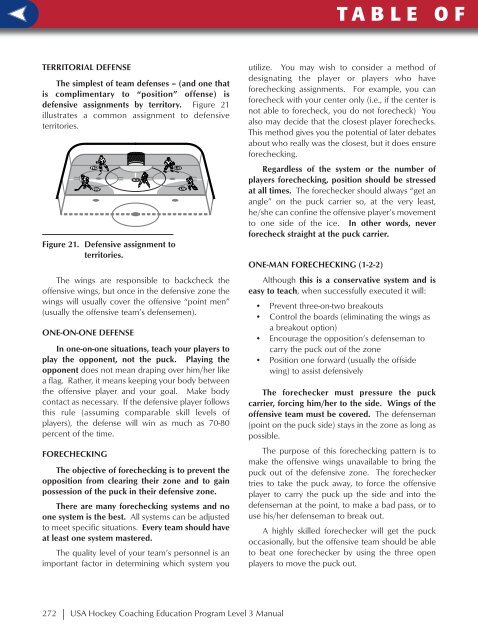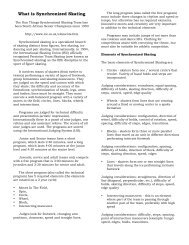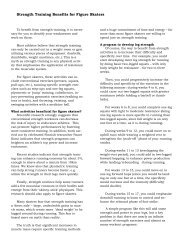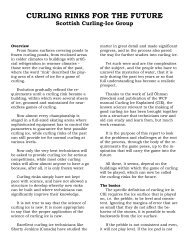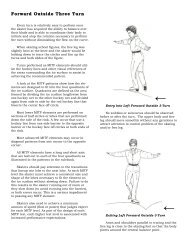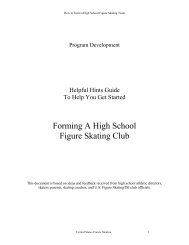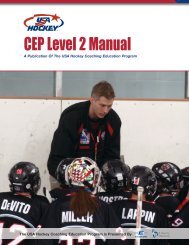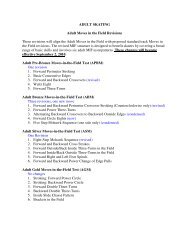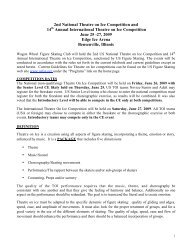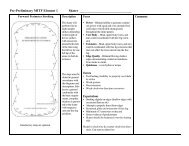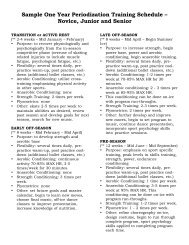CEP Level 3 Manual - Rushmore Hockey Association
CEP Level 3 Manual - Rushmore Hockey Association
CEP Level 3 Manual - Rushmore Hockey Association
Create successful ePaper yourself
Turn your PDF publications into a flip-book with our unique Google optimized e-Paper software.
T A B L E O F C O N T E N T STERRITORIAL DEFENSEThe simplest of team defenses – (and one thatis complimentary to “position” offense) isdefensive assignments by territory. Figure 21illustrates a common assignment to defensiveterritories.RDRWFigure 21. Defensive assignment toterritories.The wings are responsible to backcheck theoffensive wings, but once in the defensive zone thewings will usually cover the offensive “point men”(usually the offensive team’s defensemen).ONE-ON-ONE DEFENSEIn one-on-one situations, teach your players toplay the opponent, not the puck. Playing theopponent does not mean draping over him/her likea flag. Rather, it means keeping your body betweenthe offensive player and your goal. Make bodycontact as necessary. If the defensive player followsthis rule (assuming comparable skill levels ofplayers), the defense will win as much as 70-80percent of the time.FORECHECKINGCThe objective of forechecking is to prevent theopposition from clearing their zone and to gainpossession of the puck in their defensive zone.There are many forechecking systems and noone system is the best. All systems can be adjustedto meet specific situations. Every team should haveat least one system mastered.The quality level of your team’s personnel is animportant factor in determining which system youLDLWutilize. You may wish to consider a method ofdesignating the player or players who haveforechecking assignments. For example, you canforecheck with your center only (i.e., if the center isnot able to forecheck, you do not forecheck) Youalso may decide that the closest player forechecks.This method gives you the potential of later debatesabout who really was the closest, but it does ensureforechecking.Regardless of the system or the number ofplayers forechecking, position should be stressedat all times. The forechecker should always “get anangle” on the puck carrier so, at the very least,he/she can confine the offensive player’s movementto one side of the ice. In other words, neverforecheck straight at the puck carrier.ONE-MAN FORECHECKING (1-2-2)Although this is a conservative system and iseasy to teach, when successfully executed it will:• Prevent three-on-two breakouts• Control the boards (eliminating the wings asa breakout option)• Encourage the opposition’s defenseman tocarry the puck out of the zone• Position one forward (usually the offsidewing) to assist defensivelyThe forechecker must pressure the puckcarrier, forcing him/her to the side. Wings of theoffensive team must be covered. The defenseman(point on the puck side) stays in the zone as long aspossible.The purpose of this forechecking pattern is tomake the offensive wings unavailable to bring thepuck out of the defensive zone. The forecheckertries to take the puck away, to force the offensiveplayer to carry the puck up the side and into thedefenseman at the point, to make a bad pass, or touse his/her defenseman to break out.A highly skilled forechecker will get the puckoccasionally, but the offensive team should be ableto beat one forechecker by using the three openplayers to move the puck out.LDLWFigure 22. One-man forechecking.The basic alignment illustrated in Figure 22 usesthe center (C) to forecheck the puck carrier. Thewings (LW/RW) stay wide so they can check theopposition’s wings, and the defensemen (LD/RD)play inside the wings.NOTES: One-Man Forechecking• Stress pressuring the puck carrier andcovering the areas that the puck is likely togo• Prevent the opposition from breaking outthree-on-two. This is accomplished bykeeping both wings back and controlling theboardsTWO-MAN FORECHECKING (1-1-3)Two-man forechecking is most successful whenthe puck carrier is in the back of an imaginary lineacross the top of the face-off circles. This is shownas the shaded area in Figure 23.Figure 23. Two-man forechecking.CThis forechecking system combinesaggressiveness with the conservatism of the 1-2-2system just discussed. One forward, usually a wing,plays back to prevent a three-on-two breakout. Theremaining two forwards have an aggressiveRDRWforechecking responsibility and must exert pressureon the puck carrier.When successful, this system may result in quickcounterattacks on goal since the one defensiveforward is in a position to move quickly to the slot.For illustrative purposes (See Figure 24), twoforwards, the center and puck-side wing (RW) areassigned forechecking responsibilities. The off-sidewing (LW) stays high in the offensive zone. The LWis in a position to move back to become adefenseman or to move to the slot area. Thedefensemen take normal positions.LWFigure 24. Two-man forechecking positions.The objective of this configuration is to havethe off-side wing (LW) control the far board whichpressures the opposition to bring the puck upthrough the forechecking forwards (C and RW).The first forward (RW) forechecks the puck carrierand the center is in a position to assist the RW ormove to the puck if the RW is beaten. The RD ispermitted to pinch in toward the boards and the LDis responsible for the middle (see Figure 25).LWLDLDFigure 25. Movements of the forwards.The forwards will often have to rotate. Asindicated in Figure 26, when the play moves fromone side to the other, the off-side wing (LW) willbecome the forechecker and the puck side wingCCRWRDRWRD272 | USA <strong>Hockey</strong> Coaching Education Program <strong>Level</strong> 3 <strong>Manual</strong>Defensive Team Tactics | 273


